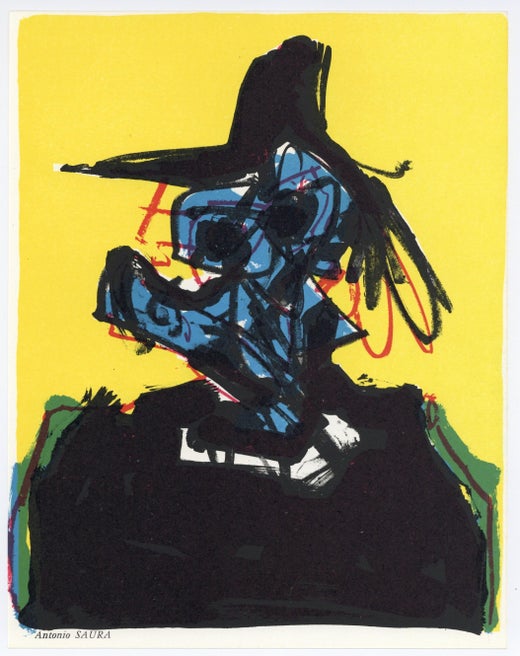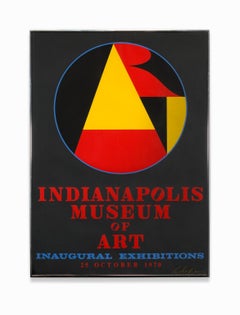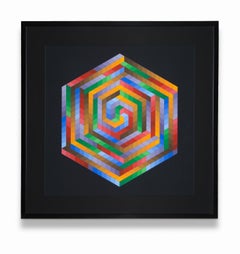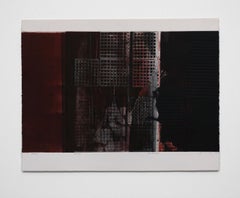Want more images or videos?
Request additional images or videos from the seller
1 of 11
Antonio Saura"Untitled" Collage Style Silkscreen Print, Colors, Outsider Art, Signed, Dated1962
1962
$3,500List Price
About the Item
- Creator:Antonio Saura (1930, Spanish)
- Creation Year:1962
- Dimensions:Height: 35 in (88.9 cm)Width: 26.25 in (66.68 cm)
- Medium:
- Movement & Style:
- Period:
- Condition:
- Gallery Location:Detroit, MI
- Reference Number:1stDibs: LU128617297152
Antonio Saura
Antonio Saura (1930 – 1998) was a Spanish artist and writer, one of the major post-war painters to emerge in Spain in the fifties whose work has marked several generations of artists and whose critical voice is often remembered. He began painting and writing in 1947 in Madrid while suffering from tuberculosis, having already been confined to his bed for five years. In his beginnings he created numerous drawings and paintings with a dreamlike surrealist character that most often represented imaginary landscapes, employing a flat smooth treatment that offers a rich palette of colors. He claimed Hans Arp and Yves Tanguy as his artistic influences. The first appearances in his work of forms that will soon become archetypes of the female body or the human figure occur in the mid-1950s. Starting in 1956 Saura tackled the register of what will prove to be his greatest works: women, nudes, self-portraits, shrouds and crucifixions, which he painted on both canvas and paper. In 1957 in Madrid he founded the El Paso Group and served as its director until it broke up in 1960. Limiting his palette to blacks, grays and browns, Saura asserted a personal style that was independent of the movements and trends of his generation. His work followed in the tradition of Velasquez and Goya. Starting in 1959 he began creating a prolific body of works in print, illustrating numerous books including Cervantes’s Don Quijote, Orwell’s Nineteen Eighty-Four, Nostlinger’s adaptation of Pinocchio, Kafka’s Tagebucher, Quevedo’s Three Visions, and many others.
About the Seller
5.0
Vetted Professional Seller
Every seller passes strict standards for authenticity and reliability
Established in 2014
1stDibs seller since 2019
110 sales on 1stDibs
Typical response time: 12 hours
Authenticity Guarantee
In the unlikely event there’s an issue with an item’s authenticity, contact us within 1 year for a full refund. DetailsMoney-Back Guarantee
If your item is not as described, is damaged in transit, or does not arrive, contact us within 7 days for a full refund. Details24-Hour Cancellation
You have a 24-hour grace period in which to reconsider your purchase, with no questions asked.Vetted Professional Sellers
Our world-class sellers must adhere to strict standards for service and quality, maintaining the integrity of our listings.Price-Match Guarantee
If you find that a seller listed the same item for a lower price elsewhere, we’ll match it.Trusted Global Delivery
Our best-in-class carrier network provides specialized shipping options worldwide, including custom delivery.You May Also Like
"BROKEN MIRROR 03242018 607pm", Primitive, Digital Print, Flag, Purple, Red
By Justin Neely
Located in Toronto, Ontario
The abstract print "BROKEN MIRROR 03242018 607pm" is a digital artwork, created with the Brushes Redux iPhone app, and printed at 36x36" on museum-quality Canson Platine Fibre Rag 310gsm archival paper. As the title indicates, the artwork was created on March 24, 2018 at 6:07 pm.
While Justin Neely...
Category
21st Century and Contemporary Outsider Art Abstract Prints
Materials
Archival Paper, Archival Pigment, Digital Pigment
Lithograph from from the Artsounds Collection, signed/n famed cult artist LGBTQ
By Thomas Lanigan-Schmidt
Located in New York, NY
Thomas Lanigan-Schmidt
Untitled, from from the Artsounds Collection, 1986
Lithograph on paper
Signed and numbered from the edition of 200 in ink on the back; also bears artist's stamped name and provenance - Art Sounds portfolio.
12 × 12 inches
Unframed
Signed and numbered from the edition of 200 in ink on the back; also bears artist's stamped name and provenance - Art Sounds portfolio.
This terrific offset lithograph print exemplifies the combination of religion and kitsch that Lanigan Schmidt is best known for. This print was created in the 1980s for the famous Artsounds portfolio, which featured prints by Marcel Duchamp, Jonathan Borofsky among others. Lanigan-Schmidt was a subject of a 2013 retrospective at PS1 MOMA and is on the faculty of the School of Visual Arts in New York.
Provenance:
Artsounds Portfolio
About Thomas Lanigan-Schmidt:
Thomas Lanigan-Schmidt is represented in the collections of the Metropolitan Museum of Art, Whitney Museum of American Art, MoMA, Brooklyn Museum, Ludwig Forum für Internationale Kunst, Ackland Art Museum, Columbus Museum of Art, and Wadsworth Atheneum Museum of Art, among others. He has exhibited extensively throughout the United States and Europe, including the 1980 and 1984 Venice Biennales, the 1991 Whitney Biennial, and the 1999 exhibition The American Century: Art and Culture, 1950-2000, Whitney Museum of American Art, New York, NY. Recent solo exhibitions include Tenemental: With Sighs Too Deep for Words, Howl! Happening, New York (2018); Thomas Lanigan-Schmidt: Mysterium Tremendum, Rockland Art Center, NY (2013); and Ecce Homo: Thomas Lanigan-Schmidt & The Art of Rebellion, Pavel Zoubok...
Category
1980s Outsider Art Figurative Prints
Materials
Lithograph
Leaving Home (97-301), 5 color lithograph on Rives BFK paper, Signed/N Tamarind
By DeLoss McGraw
Located in New York, NY
DeLoss McGraw
Leaving Home (97-301), 1997
Five color lithograph on tan Rives BFK paper with deckled edges
Signed and numbered 3/75 in graphite pencil on the front
17 × 24 3/25 inches...
Category
1990s Outsider Art Abstract Prints
Materials
Lithograph
Neighborhood
By Valton Tyler
Located in Dallas, TX
In The New York Times Arts in America column, Edward M. Gomez writes of Valton Tyler, "visionary seems the right word for describing his vivid, unusual and technically refined painti...
Category
1970s Outsider Art Abstract Prints
Materials
Paper, Etching, Aquatint
Avenue 11
By Valton Tyler
Located in Dallas, TX
In The New York Times Arts in America column, Edward M. Gomez wrote of Valton Tyler, "visionary seems the right word for describing his vivid, unusual and technically refined paintin...
Category
1960s Outsider Art Abstract Prints
Materials
Rag Paper, Etching
Stop Playing and Get to Work
By Valton Tyler
Located in Dallas, TX
In The New York Times Arts in America column, Edward M. Gomez wrote of Valton Tyler, "visionary seems the right word for describing his vivid, unusual and technically refined paintin...
Category
1960s Outsider Art Abstract Prints
Materials
Rag Paper, Etching
Together We Are
By Valton Tyler
Located in Dallas, TX
In The New York Times Arts in America column, Edward M. Gomez wrote of Valton Tyler, "visionary seems the right word for describing his vivid, unusual and technically refined paintin...
Category
1960s Outsider Art Abstract Prints
Materials
Rag Paper, Etching
Heritage
By Valton Tyler
Located in Dallas, TX
In The New York Times Arts in America column, Edward M. Gomez wrote of Valton Tyler, "visionary seems the right word for describing his vivid, unusual and technically refined paintin...
Category
1960s Outsider Art Abstract Prints
Materials
Rag Paper, Etching, Aquatint
Just a Little Water Please
By Valton Tyler
Located in Dallas, TX
In The New York Times Arts in America column, Edward M. Gomez wrote of Valton Tyler, "visionary seems the right word for describing his vivid, unusual and technically refined paintin...
Category
1960s Outsider Art Abstract Prints
Materials
Rag Paper, Etching, Aquatint
Environment Man
By Valton Tyler
Located in Dallas, TX
In The New York Times Arts in America column, Edward M. Gomez wrote of Valton Tyler, "visionary seems the right word for describing his vivid, unusual and technically refined paintin...
Category
1970s Outsider Art Abstract Prints
Materials
Rag Paper, Etching
More From This Seller
View AllGiuseppe Capogrossi Iconic Comb Design "Superficie 324" Serigrafia
By Giuseppe Capogrossi
Located in Detroit, MI
"Superficie 324" is a 1988 screen print (serigraph) of a 1959 painting by Capogrossi. This is one of his famous "comb" or "fork" works that he perfected in the 1950s and continued to create for the remainder of his life. The blocks of primary red and yellow colors give a bright, joyful feel and contrast to the strong bold black that was Capogrossi's consistent color for the "combs". With no allegorical, psychological, or symbolic meanings, these structural elements could be assembled and connected in countless variations. Intricate and insistent, Capogrossi's signs determined the construction of the pictorial surface. This piece is identified along one side: Giuseppe Capogrossi By SIAE 1988 Silvio Zamorani Editor Via Saccarelli, 9 10144 Torino Italy Tel. (39)(11) 4730554 Progetto Grafico (Graphic Project): Studio Walter Benjamin. Serigrafia (Screen Print): BISI Torino.
Capogrossi was born in Rome. After obtaining a degree in law in 1923–1924, he decided to study painting with Felice Carena at Accademia di Belle Arti di Roma. In 1927 Capogrossi embarked on a formative trip to Paris together with fellow artists and acquaintances Fausto Pirandello, Corrado Cagli and Emanuele Cavalli...
Category
1950s Abstract Expressionist Abstract Prints
Materials
Screen
"Indianapolis Museum of Art Inaugural Exhibitions", Color Silkscreen, Signed
By Robert Indiana
Located in Detroit, MI
"Indianapolis Museum of Art Inaugural Exhibitions", 25 October 1970, is an eye popping large bold colorful geometric abstract silk screen. It is signed on the lower right.
Robert Indiana, one of the preeminent figures in American art since the 1960s, played a central role in the development of assemblage art, hard-edge painting, Pop art, Neo-Dada, American Modernism and Modern Art. A self-proclaimed “American painter of signs,” Indiana created a highly original body of work that explores American identity, personal history, and the power of abstraction and language, establishing an important legacy that resonates in the work of many contemporary artists such as Andy Warhol, Keith Haring, Roy Lectenstein, David Hockney, Romero Britto, Richard Hamilton and Robert Rauschenberg who make the written word a central element of their oeuvre.
Robert Indiana was born Robert Clark in New Castle, Indiana on September 13, 1928. Adopted as an infant, he spent his childhood moving frequently throughout his namesake state. At 14 he moved to Indianapolis in order to attend Arsenal Technical High School, known for its strong arts curriculum. After graduating he spent three years in the U.S. Air Force and then studied at the Art Institute of Chicago, the Skowhegan School of Sculpture and Painting in Maine, and the Edinburgh College of Art in Scotland.
In 1956, two years after moving to New York, Indiana met Ellsworth Kelly, and upon his recommendation took up residence in Coenties Slip, where a community of artists that would come to include Kelly, Agnes Martin, James Rosenquist, and Jack Youngerman had studios. Indiana, like some of his fellow artists, scavenged the area’s abandoned warehouses for materials, creating sculptural assemblages from old wooden beams, rusted metal wheels, and other remnants of the shipping trade that had thrived in Coenties Slip. The discovery of 19th century brass stencils led to the incorporation of brightly colored numbers and short emotionally charged words onto these sculptures as well as canvases, and became the basis of his new painterly vocabulary.
Although acknowledged as a leader of Pop, Indiana distinguished himself from his Pop peers by addressing important social and political issues and incorporating profound historical and literary references into his works. In 1964 Indiana accepted Philip Johnson’s invitation to design a new work for the New York State Pavilion at the New York World’s Fair, creating a 20-foot EAT sign...
Category
1970s American Modern Abstract Prints
Materials
Paper, Ink, Screen
Victor Vasarely Screen Print Abstract, Geometric Squares Cubes Hexagon
By Victor Vasarely
Located in Detroit, MI
Victor Vasarely born in 1906 was a Hungarian-French artist, who is widely accepted as a "grandfather" and leader of the Op Art movement. Op Art is a form of abstract art that gives the illusion of movement by the precise use of pattern and color, or in which conflicting patterns emerge and overlap. Victor Vasarely and Brigit Riley are its most famous exponents. In its visual balancing act of color and movement from a flat plane to developed continuous flow “Untitled” is a complex arrangement of squares and colors that visually expand and contract. It is one of Vasarely’s most successful Op Art abstract works. The piece is signed on the lower right and number 20/150 on the lower left. The print is behind glass and matted.
Vasarely was born in Pecs and grew up in Slovakia and Budapest, where in 1925, he took up medical studies. Abandoning medicine he turned to traditional academic painting at the private Podolini-Volkmann Academy. In 1928/1929, he enrolled at Sandor Bortnyik’s private art school widely recognized as Budapest's centre of Bauhaus studies. His studies concentrated on applied graphic art and typographical design. In 1929, he painted his Blue Study and Green Study. In 1930, he married his fellow student Claire Spinner (1908–1990). Together they had two sons, Andre and Jean-Pierre. Vasarely became a graphic designer and a poster artist during the 1930s combining patterns and organic images with each other.
Vasarely utilized geometric shapes and colorful graphics, the artist created compelling illusions of spatial depth, as seen in his work Vega-Nor (1969). Vasarely’s method of painting borrowed from a range of influences, including Bauhaus design principles, Wassily Kandinsky, and Constructivism. In the late 1920s, Vasarely enrolled at the Muhely Academy in Budapest, where the syllabus was largely based on Walter Gropius’s Bauhaus school in Germany.
After settling in Paris in 1930, Vasarely worked in advertising agencies to support himself as a graphic artist while creating many works including Zebra (1937), which is considered by some to be one of the earliest examples of Op Art. The artist experimented in a style based in Surrealism and Abstract Expressionism during the 1940s, before arriving at his hallmark checkerboard...
Category
Mid-20th Century Op Art Abstract Prints
Materials
Paper, Screen
Joyce T. Nagel Collagraph "Grid Melt" Deep Rich Colors Signed Dated
Located in Detroit, MI
"Grid Melt" is one of the monoprints that Joyce Nagel so enjoyed creating. Being a monoprint makes this piece totally unique and unlike any of the other pi...
Category
1980s Abstract Prints and Multiples
Materials
Paper, Ink
Joyce T. Nagel Monoprint Abstract "Dropout" Signed Dated
Located in Detroit, MI
"Dropout" is one of the monoprints that Joyce Nagel so enjoyed creating. This monoprint is a one-off abstract print. The arrangement of shapes and colors p...
Category
1980s Abstract Expressionist Abstract Prints
Materials
Paper, Ink
Joyce T. Nagel Print "Vegetable Forms No. 9" "1st State" Signed Dated Ltd Ed
Located in Detroit, MI
"Vegetable Forms No. 9" "1st State" is a beautiful linear design woodcut of an artichoke. What is intellectually interesting is the fractal beauty of nature found in the artichoke. A fractal is a kind of pattern that we observe often in nature and in art. Whenever you observe a series of patterns repeating over and over again, at many different scales, and where any small part resembles the whole, that’s a fractal. The Artichoke is the perfect example in that the shape of the leaves repeat themselves and they are the same shape as the fruit itself. Fractals are exciting, not only for their mathematical or conceptual representation, but also for the fact that you can visualise the math—and it’s beautiful! This print is rendered in an intense green with a light blue color to delineate the intriguing linear element of the artichoke's leaves.
Joyce Tilley Nagel...
Category
1970s Abstract Abstract Prints
Materials
Paper, Ink



